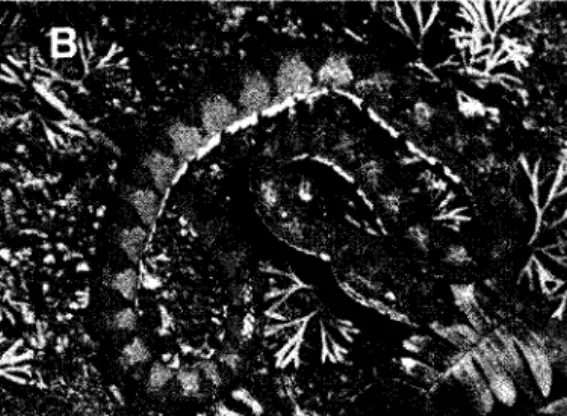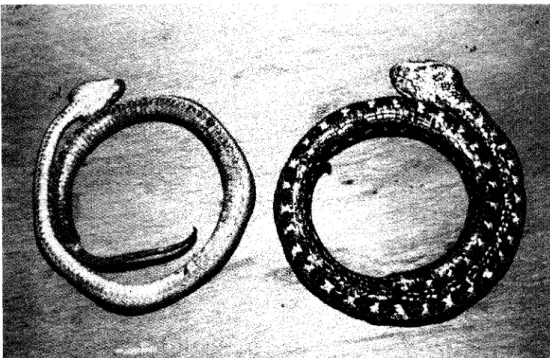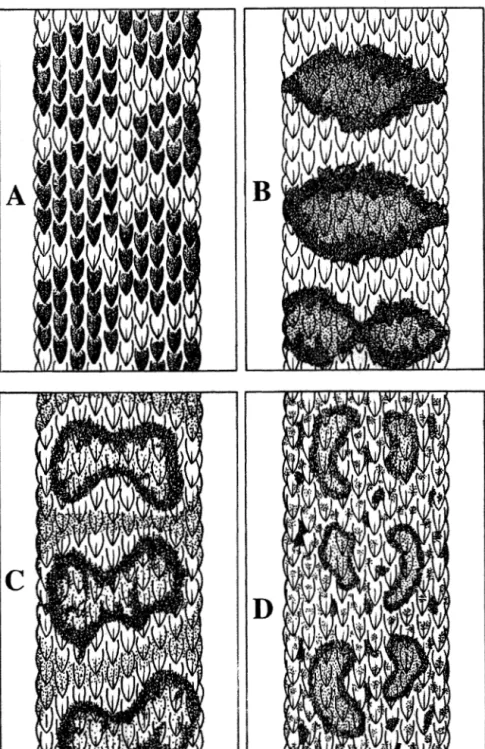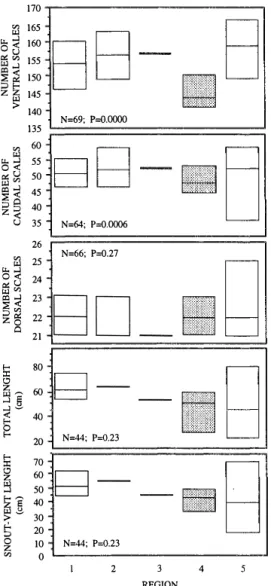Redescription and validation of Bothriechis supraciliaris (Serpentes: Viperidae)
Texto completo
(2) REVISTA DE BIOLOGIA TROPICAL. 454. a review. Based on coloration and scale counts we propose that Taylor's taxon is a discrete entity and should be accorded specific rank.. MATERIALS AND METHODS Fifty-seven. specimens of typical (sensu lato), from various parts of Costa Rica and twenty-five specimens collected in the forest reserve of the Las Cruces Biological Station, Coto Brus, Puntarenas, at 1000-1400 m a.s.l., were compared (numbers and localities in Appendix 1) for scale counts and for color pattems of live specimens.. Bothriechis schlegelii. RESULTS. Scale counts: Coto Brus specimens (Table 1 and Fig. 4): dorsal rows 21-23; supralabials 7-11; infralabials 10-12; interoculars 6-9; preoculars 2-4; postoculars 24; 1 elongated subocular; 1-2 (rarely 3) scales between subocular and supralabials; anal scale entire. Dorsal scales keeled, except for paraventrals. Dorsocaudals keeled. Color pattern: Specimens from Coto Brus have consecutive, well-defined blotches of variable shapes (circular, rhomboidal, disjunct circles and bands, transverse banding). along center of dorsum, ranging from coffee brown or dark green to rusty brown or reddish maroon. These pattems visibly differ from the rather diffuse coloration of all specimens known from elsewhere in Costa Rica (Figs. 13). Additionally, the ground color of the Coto Brus specimens, albeit highly variable in hues and shades, is almost always uniform and lacks secondary pigments, while the dorsal ground coloration of specimens from elsewhere in the country is highlighted by a variety of dots, spots or bars of secondary pigmentation (Figs. 1 and 3). Furthermore, the "oropel" morph of typical B. schlegelii, yellowish to golden orange, so well known from other Costa Rican sites is extremely rare in the General-Coto Brus area, where only one specimen (immature male) was seen in ten years of observatÍons by one of the authors (L.D.G.). Ventral coloration outside Coto Brus is equally enriched by scattered dots and spots, while in specimens from Coto Brus the ventral aspect is devoid of pigments at least in the anterior two thirds of the body length (Fig. 3), the caudal portion rarely has diffuse, dark, purplish brown hues mostly visible in preserved material. Lepidosis: Specimens from Coto Brus and those from elsewhere in Costa Rica differ in number of ventral and caudal scales (Fig. 4). There are no significant differences in length and number of dorsal scales (Fig. 4).. TABLE 1 Ventral and caudal scale counts in Bothriechis schlegelii and B. supraciliaris. Mean in bold to facilitare comparisons. Ventrals Caudals. Males Females Males Females. Mean 160.1 156.8 56.8 51.6. B. schlegelií Range S.D. 153-167 2.44 146-167 4.75 53-61 2.44 33-61 4.34. N 9 48 9 43. S.D. Standard Deviation. Range (Minimum-Maximum). N SampJe size.. Mean 147.3 143.9 50.2 47.3. B. supraciliaris S.D. Range 2.22 145-150 2.13 141-148 2. 63 48-54 2.06 45-52. N 4 14 4 14.
(3) SOLORZANO et al.: Redescription and validation of Bothriechis supraciliaris (Serpentes: Viperidae). 455. Fig. 1. Variation of color pattems. A-D B. supraciliaris, E B. schlegelii, all from Costa Rica (photographs: A, B: M. & P. Fogden; e, D, E: A. Solórzano)..
(4) REVISTA DE BIOLOGIA TROPICAL. 456. Fig. 2. Ventral view of B. supraciliaris (left) and 01' B. schlegelii. Based on these results, we conclude that warrants specific recognition and it is here redescribed: Bothriechis supraciliaris. Bothriechis supraciliaris. (Taylor 1954), Fig. 1.. Diagnosis: Closely related to B. schlegelii from which it differs by its color pattems based on a uniform ground color with polymorphic, dorsal designs and its lower counts of ventral and caudal scales. Description: Pitviper of small to moderate size (maximum 600 mm), prehensile tail and strongly tliangular outline of head and, from Taylor's original description: "Front of snout rounding, coyered by about 70 strongly keeled scales anterior to level of the supraoculars; rostral approximately as wide as high, not visible aboye; on canthus a tiny median scale aboye rostral; each undivided nasal bordered aboye by three scales with free outer edges; loreal separated from the upper. preocular by one small scale; these three scales bordered aboye by five scales, three of which haye the keels strongly elevated into soft, flattened "spines" and forming a line with the two elevated supraorbital spines; the supraoculars divided, each bealing one or two small, spine-like outer projections; supraoculars separated from the eyes by a row of ten small granular scales; the next row consists of about five scales, two of which are the elevated supraorbital spines, this row separated from orbit by eight or nine small granules, two or three small postoculars; a long natrow subocular ruus under orbit to or very close to the lower preocular; three preoculars, the median and lower border pit; second labial separated from lower preocular by small scale, broadly enteling pit and with a scale bordering it aboye forrns the anterior border of pit; the second labial has no partial suture entering from its anterior edge; three to five small lower loreals (prefoveals); 9-10 supralabials, the first continuously bordeling the nasal; the third, fomth, and sixth sepat"ated from the subocular.
(5) SOLORZANO et al.: Redescription and validation of Bothriechis supraciliaris (Serpentes: Viperidae). Fig. 3. Dorsal scale pattem in B. supraciliaris (A-C) and of B. schlegelii (D).. 457.
(6) REVISTA DE BIOLOGIA TROPICAL. 458. 170 (Il 165 III. -l ¡,¡.< 0 ¡>:;;; Ill ¡r¡-l <. �� Z �. 160 155 150 145 140 135. '". ¡,¡.-lIII 0< U ¡>:'" Ill -l ¡r¡< ::;: ;:,0 Z� u. 60 55 50 45 40 35 26. '". ¡,¡. -lIII 0< ¡>:u Ill'" ¡r¡-l < ::;: ;:,'" z(!5. O. ti:. 25. � ti:. '". Z. � �e. �� §o Z en. .:' .. N=69;. P=o.OOOO. N=64; P:OOOO6. Our scale counts of the holotype agree with Taylor's, except that the caudals are 47. There is a marked sexual dimorphism: the females are ¡onger and thicker (pers. observo of 14 females and 4 males) as in B. schlegelii.. N=66; P:O.27. 24 23 22 21. 80. '". Z Ill� -l e -l� <. B BB-·U. 60. 40 20. EJD_ g. Natural history: B. supraciliaris may tend to spend more time on the ground than other palm or eyelash pitvipers: 22 out of 25 were found on the forest floor. T he stomach contents of four dissected specimens consisted mostly of small rodents of the forest floor.. ---. N=44; P=O.23. 70 60 50 40. g-. 30 20 10. following pairs, but distinctly smaller but perhaps a little wider than the first pair of labials; temporal scales keeled strongly, the keels compressed and elevated; about 56 scales across head at angle of jaw; no scales between nasal and rostral. Scale formula: 25, 23, 23, 23, 19, 19; ventrals (counting from first wídened scale), 146, caudals 46, anal single; the terminal scute of tail rather large; the tail a tip with six rows of scales; 15 in the postanal regíon; all scales except outer row, and scales on underside of head, keeled.". N=44; P=O.23. O 2. 4 REGION. Fig. 4. Descriptive morphometry of populations previously considered "B. schlegelit' in five regions of Costa Rica. The country was divided in five sections: 1 North Pacific, 2 Central Pacific, 3 South Pacific, 4 San Vito de Coto Bms and San Isidro de Pérez Zeledón and 5 Caribbean. Section 4 differs significantly from the other areas, which are statistically similar among themselves (Kruskal-Wallis ANOVA and Tukey test, p<O.05). Values are: maximum, mean and mínimum. Sample sizes vary because sorne specirnens were damaged.. by three scaJe rows; infralabials 12-12, only two of which touch the first chinshields; first pair of chinshields much larger than the three. Specimens collected in resting positions were found curled in a loose circle and mostly on horizontal, wide surfaces, while typical schlegelii often droop and loop on forks of stems and branches or form a tight S shaped pattem on almost vertical, rough barked tree trunks. T he following specimens are proposed as neoparatypes, deposited at Museo de Zoología, Universidad de Costa Rica (UCR) and Collectíon of Vertebrates, University of Texas at Arlington (UTA): Alturas del Río Cotón, Coto Brus, Puntarenas Prov., 1500 m UCR-12082; Estación Biológica Las Cruces, Coto Brus, 1000-1400 m, Puntarenas Prov. UCR- 10641, 12075-12081, 13500-13502, 2276, 2277. UTA R-35192, 35193, 35194, 35246..
(7) SOLORZANO et al.: Redescription and valídation of Bothriechis supraciliaris (Serpentes: Viperídae). DISCUSSION. enhanced by the existence of other cases (Solórzano. Among neotropical pitvipers Bothriechis schlegelii. is. particularly. 1995),. such. Porthidium. as. volcanicum Solórzano and its vicar P. lansbergii,. for. its. or by Lachesis muta melanocephala Solórzano. color variation throughout. its. & Lamar 1989). Its usual habitat is lowland. & Cerdas (1986) whose color pattem and scaling L. muta muta than to L. muta stenophrys from the Atlantic. rainforests although it is also known from. versant of Costa Rica. In contrast, Zamudio and. impre,ssive. known. 459. geographical range (Werman. 1984, Campbell. moderate to bigh elevations (Campbell. &. 1989, Crother et al. 199:2). In Costa. Lamar. is closer to the South American. Greene. (1997) defend a greater affinity between. this and stenophrys.. Rica B, schlegelii is amply distributed in the Caribbean and southern Pacific lowlands, but. Unlike Werman. (1984), we used. a. larger. the Pacific rauge is geographicaly isolated. sample. from the rest of the country (Crother et al.. differences in the number of ventral and caudal. 1992).. scales.. that. has. Allozyme. evidenced. significant. comparisons. of. five. individuals from Coto Bros, one from Upala in Recently, the systematics of the genera. NE Costa Rica, and one from Ciudad Neily,. Bothrops and Bothriechis has been the subject. km. of diverse morphological and biochemical. differentiation (Crother, unpublished).. & Lamar 1989, 1992, Sh1itti et al. 1990, Shaui & Kramer 1991, Cadle 1992, Crother et al. 1992, Werman 1992, Kuch and Freire 1995, Wüster and McCarthy 1996). Taylor's (1954) keen observation of a single specimen (Type, KV. 31997) was notable and. SW. of. Coto. Brus,. support. 35 the. studies (CampbeH. The geographical range of supraciliaris seems to be confined to mid and higher elevations. (800-1700 m) (Appendix 1). For. schlegelii, the range is ampler but mostly confined to lowland rainforests outside and. gross differences shown by the material at. within SW Costa Rica. To date, we have found. hand. main. no overlap oi the ranges of the two taxa. There. parameters used for bis description were not,. is a closer similarity in squarnation between. were. correct,. although. the. as he based the distinction on the aspect and. Costa. morphology of sorne scales that often are. schlegelii (se.e Renjifo. ontogenetically variable within the species,. statistics of Colombian populations).. Rican supraciliaris and Colombian. 1979 for summary. such as the divided supraoculars and the color of the tail tipo. The species redescribed here is thus far only known from the Valle del General and the. This study shows that, despite normal. Coto Brus altiplano in SW Costa Rica, and its. from Coto Bros display a. existence. suggests that an exhaustive revision. variation, specimens. notable and constant coloration divergence. of the systernatics of Bothriechis schlegelii. from the rest of the country.. throughout its range, from Northern Perú to Mexico, would likely reveal similarly isolated. Coloration of the Costa Rican taxon is equally. and. strongly. related. to. and discrete genotypes.. sorne. morphotypes from Colombia and Ecuador as described and illustrated in Campbell & Lamar (1989). The close resemblance and affinity of the. AKNOWLEDGMENTS. SW Costa RicanPacific versan! supraciliaris to the. NW South American schlegelii seems to. W. Lamar. M. Gutiérrez and two. We are grateiul to. William. support fue hypothesis of an ancestral continuum. Mahmoud Sasa, José. of a schlegelii stock, a hypothesis further. anonymous reviewers for suggestions to greatIy.
(8) REVISTA DE BIOLOGIA TROPICAL. 460. irnprove tbis rnanuscript, and to Alberto León S. for bis drawings. Michael and Patricia Fogden supplied sorne photographs. The Organization for Tropical Studies, provided logística! support for the two senior authors.. Peters J.A. & B. Orejas-Miranda. 1 970. Catalogue of the Neotropical Squamata. Part I. Snakes. Bull. U.S. Nat!. Mus. 297: 1 347. Renjifo, J.M.. 1 979. Systematics and distribution of. Crotalid snakes in Colombia. MS Thesis, Universíty of Kansas, Lawrence, 64 p. Savage, J.M.. 1 973.. A. prelimary. handlist. of. the. herpetofauna of Costa Rica. Univ. S. California, Los. RESUMEN. Angeles, California, 1 7p.. Las poblaciones de toboba de pestañas o bocaracá. Savage,J.M. 1 980. A handlist with prelillÚnary keys to the. del suroeste de Costa Rica han sido denollÚnadas tradicio. herpetofauna of Costa Rica. J. Allan Hancock. nalmente Bothriechis schlegelii supraciliaris Taylor 1954.. Foundation, Los Angeles, California, 1 1 1 p.. Sin embargo, la morfometría y el patrón de coloración sugieren que es una especie aparte, que aquí se propone como Bothriechis supraciliaris stat.nov.. Schiitti, B. & E. Kramer. 1 99 1 . A new pitviper from Ecuador, Bothriechis mahnerti n. sp. Rev. Suisse Zoo\. 98: 9 - 1 4. Schlitti, B.; E. Kramer & J.M. Touzet. 1990. Systematic remarks on a rare crota1id snake from Ecuador,. REFERENCES. Bothriechis. Berthold, A.A. 1 846. Ueber verschiedene neue oder seltene Reptilien aus New Granada und Crustacien aus China. Abh. Ges. Wiss. Gottingen 3: 3-32.. Centro América. Universidad de Costa Rica, San José, Costa Rica, 1 36 p. Cadle, lE. 1 992. Phylogenetic relationships among Inmunological evidence.. pp. 4 1 -48.. In. JACampbell & E.D.Brodie (eds.). Biology of !he Pitvipers. Selva, Tyler, Texas.. reptiles of Latin America. Cornell University, Ithaca, New York, 425 p.. neotropical. viperids,. with. !he. description of a new genus. Occas.Papers Mus.,Texas Tech Univ. 1 53: 1 -3 1 .. Phylogeny and Historieal Biogeography of the Palm genus. Bothriechis:. Biochemical. and. Morphological Evidence, p. 1-20. In J.A. CampbelJ & E.D. Brodie, Jr.(eds.) Biology of the Pitvipers. Selva, Tyler, Texas.. U.. & A.. neotropical pitvipers. Rev. Suisse Zoo\. 97: 877-885.. venenosa terrestre del género Porthidium (Serpentes: Viperidae), del Suroeste de Costa Rica. Rev. Bio\. Trop. 42: 695-70 1 . Solórzano, A . & L . Cerdas. 1 986. A new subspecies o f the Bushmaster, Lachesis muta, from SW Costa Rica. 1. Herpeto\. 20: 463-466.. Guatemala. Mise. Pub\. Mus. Zoo\. Univ. Michigan 1 22: 1 - 1 50.. Rica. Univ. Kansas Sci. Bul!. 36: 637-80 1 . Taylor, R.T., A. Flores & R . Bolaños. 1 974. Geographical distribution of Viperidae, Elapidae and Hydrophidae in Costa Rica. Rev. Bio!. Trop. 2 1 : 383-397.. Crother, B.I., J.A. Campbell & D.M. Hillis. 1 992.. Kuch,. sorne. Taylor, E.H. 1 954. Further studies on !he serpents of Costa. Campbell, JA & w.w. Lamar. 1992. TaxonollÚc status of. Pitvipers,. with. Stuart, L.C. 1963. A checklist of the herpetofauna of. Campbell, lA. & W.w. Lamar. 1989. The venomous. miscellaneous. (Shreve),. Solórzano, A. 1 995. Una nueva especie de serpiente. Bolaños, R. 1984. Serpientes, venenos y ofidismo en. Vipers:. albocarinata. comments on the generic arrangement of arboreal. Villa, J. D. 1 984. The venomous snakes of Nicaragua: a synopsis. Contr. Milwaukee Public Museum 59: 2931. Werman, S.D. 1 984. T he taxonollÚc status of Bothrops supraciliaris Taylor. J. Herpeto!. 1 8: 484-486.. Freire.. 1 995.. Bernerkungen. zur. geographischen Verbreitung und Variabilitlit von SchIegels Palmen-Lanzenotter, Bothriechis schlegelii (BERTHOLD, 1846), in Ecuador. Herpetozoa 8: 49-58.. Werman, S.D. 1992. Phylogenetic relationships of Central and South American pitvipers of the genus Bothrops (sensu latu): Cladistic analyses of biocbellÚcal and.
(9) SOLORZANO et aL: Redescription and validation of Bothriechis supraciliaris (Serpentes: Viperidae). 461. anatomical chara�ers. p. 21-40. In J.A.eampbell &. Wüster, W. & e.J. Mcearty. 1996. Venomous snake. E.D. Brodie Jr (eds.). Biology of the pitvipers, Selva,. systematics: Implications for snake bite treatment and toxinology, p. 13-23. In e. Bon & M. Boyffon (eds.).. Tyler, Texas.. Envenomings and their treatments. Foundation Maree1 Wilson, L.D. & J.R. Meyer. 1982.. T he snakes of. Mérieux, Lyon, France.. Honduras. Milwaukee Publ. Mus. Publ., Biol. Geol. 6: Zamudio, K.R. & H.W. Greene. 1997. Phylogeography of. 1-159.. the Wilson, L.D. & J.R. Meyer. 1985.. T he snakes of. Honduras. Milwaukee Publ. Mus. Publ., Biol. Geol. 6: 1-150.. bushmaster. (Ltichesis. muta:. Viperidae):. Implications for neotropical biogeography, systematics, and conservation. Biol. J. Linn . Soco 62: 421-442..
(10) REVISTA DE BIOLOGIA TROPICAL. 462. APPENDIX 1 Studied specimens 01 Bothriechis schlegelií (from outside SW Costa Rica; for B. supraciliaris data see final paragraph 01 Results) UCR-Number 3309 2879 3628 7161 1439 6098 Heredia 3389 10439 10415 10416 3316 0013 3437 1430 7197 0326 2595 0011 10354 0102 7185 2938 2939 2740 2741 10306 2212 11471 6768 6233 3400 3405 2895. Collection locality Osa, Puntarenas Penshurt, Limón Guápiles, Limón Comadre, Limón Tilarán, Guanaeaste La Tirimbina de Sarapiquí, Turrubares, San José Brasilia de Upala, Alajuela Dos Ríos de Upala, AI'liuela Dos Ríos de Upala, Alajuela Jesús María de Turrialba, Cartago San José Tilarán, Guanacaste Puerto Viejo de Sarapiquí, Heredia Río Cuarto de Grecia, Alajuela Puerto Viejo de Sarapiquí, Heredia Sierena, Corcovado, Puntarenas San José No data San Miguel de Sarapiquí, Heredia San Clemente, Limón Penshurst, Limón Penshurst, Limón Penshurst, Limón Penshurst, Limón Pilón de Bijagua, Upala, Alajuela La Selva, Sarapiquí, Heredia Sirena de Corcovado, Puntarenas Bri-bri, Limón Turrubares, San José La Bomba, Limón Puerto Vargas, Limón Siquirres, Limón. Reference coIlection, Instituto Clodomiro Picado, . San José, Costa Rica. Speeimen Number 1234 s678910111213141516171819202122232425-. Collection locality Llano Hermoso de Puriscal, San José Mercedes Sur de Puriscal, San José Salitrales de Puriseal, San José Salitrales de Puriscal, San José Salitrales de Puriseal, San José Salitrales de Puriscal, San José Salitrales de Puriscal, San José Salitrales de Puriseal, San José Tilarán, Guanacaste Concepción, Puriscal, San José Concepción, Puriscal, San José Concepción, Puriscal, San José Concepción, Puriscal, San José Jilgueral de Puriscal, San José Jilgueral de Puriscal, San José Alto de Limón, Puriscal, San José Alto de Limón, Puriseal, San José La Gloria de Puriseal, San José La Gloria de Puriscal, San José La Gloria de Puriscal, San José Talamanca, Río Telire, Limón Turrubares, San José Los Angeles de Puriscal, San José Los Angeles de Puriseal, San José Salitrales de Puriscal, San José.
(11)
Figure




Documento similar
Campamento La Barrita, San José, Escuintla, el inicio de la construcción del Puente Sin Cabezas en San José, Escuintla, el Recapeo entre la Bifurcación CA-2 Oriente Masagua y Puerto
48 Cristobal Morales Cún Piloto Municipal Servicios
Gestión de Reportes Gerenciales: La entidad no tiene definidas, políticas, normas y procedimientos para la adecuada gestión de reportes gerenciales y de emisión de
Oficina del Ministerio Social Nuestra Oficina del Ministerio Social ofrece sus servicios durante todo el año para los pobres y carentes de vivienda.. Los artículos
Si está necesitado de oración y le gustaría que el ministerio de Cadena de Oración ore por usted, favor de comunicarse a la oficina de la parroquia al 512-444-7587 para dejar
a) Riesgos de Crédito: Es el riesgo de que se origine una pérdida financiera, como consecuencia de que un cliente o contraparte de un instrumento financiero incumpla con
48 Fiestas Patronales en Honor a San José San José / Rosario Vera Peñaloza Procesión - Misa y Fiesta Popular 49 Fiestas Patronales en honor a San José Suriyaco / San Blas de
SAN MANUEL FERNAN NUÑEZ, 5 MÁLAGA correo@colegiosanmanuel.es 952310943 JOSÉ GUTIÉRREZ GALENDE.. JOSÉ LÓPEZ